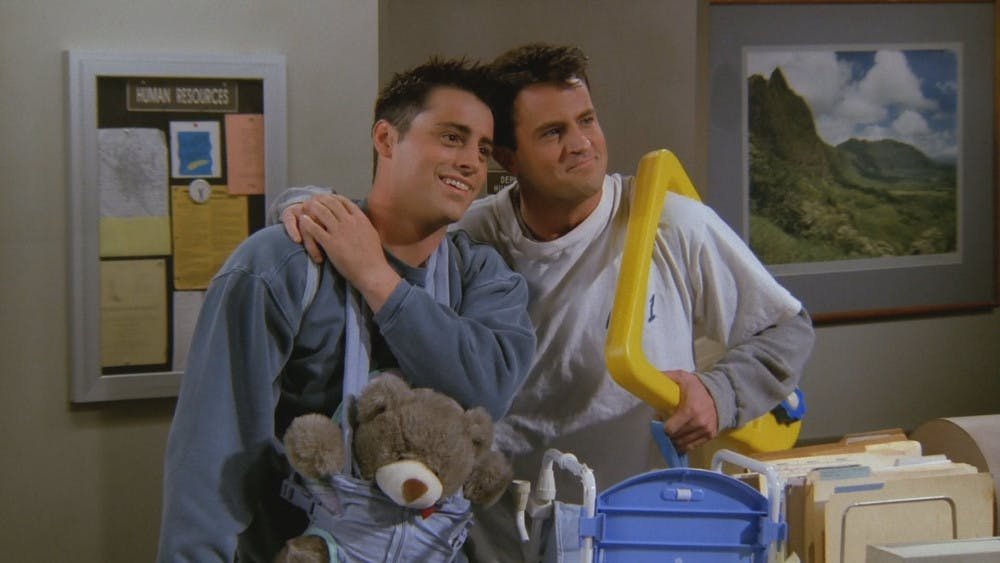by Baylie Clevenger
The iconic 90s show Friends is a favorite of people everywhere. Running for 10 seasons it has become one of the most popular shows on television.
Personally I have always been a fan of Friends, but every time I watch it, I cannot seem to ignore the problematic messages that were portrayed and accepted in the 90s.
For example: “The one with the Baby on the Bus.” Joey and Chandler are watching Ross’s son for the day. Joey tells Chandler they can go out with the baby because the baby will get them women. This is assuming that all women are complacent homemakers who love babies and anything having to do with children. While they are on the bus, a woman does approach them because she thinks the baby is cute, but then Joey and Chandler become the butt of the joke when the woman assumes that they are gay dads.
Throughout the show, more problematic messages also include when Joey was ridiculed for carrying a purse because it is “girly” when Ross is upset that his ex-wife let his son play with a doll, and the on-going joke about Chandler’s dad who is a gay burlesque dancer. Not to mention that in the entire show, I only recall ever seeing one major character of color… and of course, she was just Ross’s temporary love interest.
The concept of having only one character of color in New York City, where the show is set, is also unlikely. According to census information for the city, only about 44.7 percent of the population is white. The other 66.2 percent are people of color and/or multiracial. The only explanation is that the people who did casting for the show did not take people of color into account.
90s media was clearly different, and it is essential to recognize the problematic messages that were okay at the time. Especially in a show that was so widely popular.
Today, inclusivity is more prevalent in the media. For example the movie Love, Simon - which is set to release this March - follows the struggle of a young gay man coming out.
Other examples of inclusive media are shows like Sense8, which features characters from all different backgrounds. Naomi Marks is a transgender character played by a transgender actress, Jamie Clayton. Even the most recent Ghostbusters featured four female ghostbusters instead of four males, one of them also being a woman of color.
So, why does this matter? Inclusive media is important for a multitude of reasons.
First off, inclusive media helps to educate others and create conversation around topics like racism, homophobia and other forms of oppression.
Secondly, inclusive media makes oppressed persons feel safer and understood in a world that can be cold and closed-minded.
The evolution from Friends to modern media is impressive, but there is still a long way to go. While there are recent shows that are more inclusive and less problematic, there are still popular shows today that have harmful messages, plots, and characters.
The first one that comes to mind is Gossip Girl. It came out in 2007 and ended in 2012 and though it was created in more recent times there were still multiple issues with this show. For starters, Chuck Bass was a rapist and his relationship with Blair Waldorf was abusive and manipulative. Though these characters are in an unhealthy relationship and Chuck was a rapist, people still idolize and romanticize their behaviors.
Exhibit A:
 Exhibit B:
Exhibit B:
 There has also been praise for Gossip Girl because Eric Vanderwoodsen, a prominent character in the show, was gay. That does not change the rest of the problems within the show. Especially because of the lack of major characters of color, much like in Friends.
Media today has come a long way but as far as being problematic, there is still a long way to go.
What I can say is that at least people are not still viewing Archie Bunker’s All in the Family, but the internalized oppression that has been taught and perpetuated is still present even if it is not as obvious as it once was.
Diversity is key. More gay characters, more trans characters, and more characters of color are essential to creating a more inclusive media experience. Not only that but can there please, for the love of all that is good, be some characters that are actually the same race, sexuality, and/or gender as the character they are playing? That would be nice.
There has also been praise for Gossip Girl because Eric Vanderwoodsen, a prominent character in the show, was gay. That does not change the rest of the problems within the show. Especially because of the lack of major characters of color, much like in Friends.
Media today has come a long way but as far as being problematic, there is still a long way to go.
What I can say is that at least people are not still viewing Archie Bunker’s All in the Family, but the internalized oppression that has been taught and perpetuated is still present even if it is not as obvious as it once was.
Diversity is key. More gay characters, more trans characters, and more characters of color are essential to creating a more inclusive media experience. Not only that but can there please, for the love of all that is good, be some characters that are actually the same race, sexuality, and/or gender as the character they are playing? That would be nice.
Sources: YouTube, FactFinder, The Museum of Broadcast Television Images: YouTube, Twitter,




















